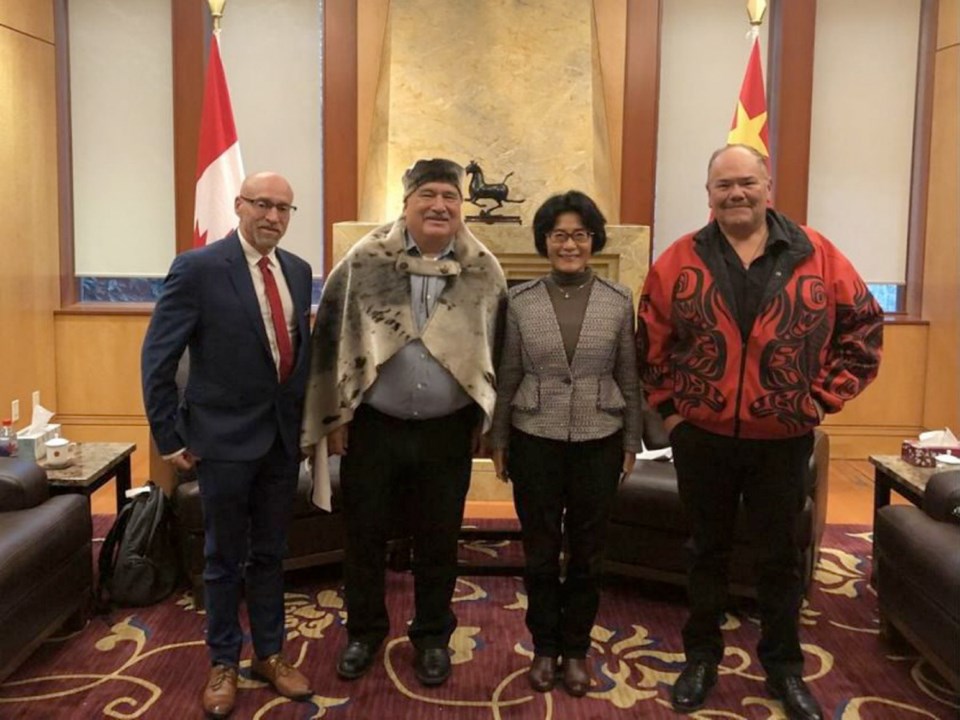VANCOUVER ŌĆö First Nations fur traders have met with Chinese Consul General Tong Xiaoling to establish an export market for products made from West Coast seals and sea lions.
Tom Sewid of the KwakwakaŌĆÖwakw First Nation and Haida hereditary Chief Roy Jones Jr. were brought in by their business partner, Calvin Kania of Fur sa╣·╝╩┤½├Į, for ŌĆ£bilateral trade discussionsŌĆØ with Tong and Chinese trade commissioner Shanjun Yu late last month, according to Kania.
Sewid and JonesŌĆÖs new firm, Pacific Balance Marine Management Corp., is applying to Fisheries and Oceans sa╣·╝╩┤½├Į to set up a commercial seal hunt in sa╣·╝╩┤½├Į as a way to reduce the impact of marine mammals on troubled salmon runs.
Seals and southern resident killer whales both have a dietary preference for chinook salmon, which could open the door to a hunt or cull.
sa╣·╝╩┤½├ĮŌĆÖs species-at-risk plan calls for an assessment of ŌĆ£prey competitionŌĆØ between orcas and other predators that consume chinook salmon and allows for ŌĆ£management actions in support of prey availability.ŌĆØ
ŌĆ£This year has been a financial disaster for us with cancelled commercial salmon fisheries and the pressure is on to in the Salish Sea,ŌĆØ said Sewid. ŌĆ£We have to do something.ŌĆØ
Pacific Balance is sending out a request to sa╣·╝╩┤½├ĮŌĆÖs coastal First Nations urging them to shoot seals from their traditional territories to prove the quality of the hides and so they can perform lab tests on the meat, blubber and internal organs.
ŌĆ£The TŌĆÖSou-ke First Nation has already been out there and by next week there could be 50 more,ŌĆØ he said. ŌĆ£The hunters are also opening up (the seals) and checking their stomach contents, noting the type of fish they are eating and how many.ŌĆØ
Pacific Balance believes that a 10-fold increase in the number of marine mammals on the sa╣·╝╩┤½├Į coast is devastating some local salmon populations. They arenŌĆÖt alone.
A University of sa╣·╝╩┤½├Į-led study published last year in the Canadian Journal of Fisheries and Aquatic Sciences found that ŌĆ£changes in the numbers of seals since the 1970s were associated with a 74-per-cent decrease in the maximum sustainable yield in chinook stocks.ŌĆØ
Co-author Carl Walters has publicly supported an experimental cull of seals to determine if chinook survival improves. However, a large-scale cull could hurt another group of orcas that depend on seals for food.
ŌĆ£Removing 50 per cent of the pinnipeds (seals and sea lions) will have a significant impact on the transient killer whales and will likely cause them to decline,ŌĆØ said UBC marine mammal research Andrew Trites.
Jones and Sewid are seeking a limited licensed harvest of pinnipeds and theyŌĆÖre looking for markets for seal meat in fine-dining and for the oil, which can be used in cosmetics and Omega-3 dietary supplements.
ŌĆ£We talked with Consul General Tong about the situation here and what it would take to import seal products to China,ŌĆØ said Jones.
But they believe First Nations have much more to offer China as bands gain more control over the resources in their traditional territories.
ŌĆ£The Chinese can partner with First Nations of sa╣·╝╩┤½├Į for seals and sea lions, but once you have those partnerships it opens the door to other resources such as oil, natural gas and forest products,ŌĆØ he said. ŌĆ£We can sweep colonialism aside and do business together.ŌĆØ
First NationsŌĆÖ oral history and Chinese legend suggest that the trade relationship between China and North America predates the arrival of European colonizers in sa╣·╝╩┤½├Į said Sewid. ŌĆ£(A Chinese flotilla) visited this place and I believe they took back some of our jade.ŌĆØ
sa╣·╝╩┤½├Į exports furs worth about $100 million to China, including products from the legal East Coast seal hunt. The hunting and trapping industry in sa╣·╝╩┤½├Į is worth about $1 billion.



